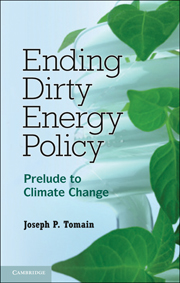Book contents
- Frontmatter
- Contents
- Preface
- Introduction
- 1 A Regulatory History of Dirty Energy Law and Policy
- 2 Protectionist Assumptions
- 3 The Next Generation Is Now
- 4 Consensus Energy Policy
- 5 Fossil Fuel Future
- 6 Electricity Future
- 7 Venture Regulation
- 8 Smart Energy Politics
- 9 Conclusion – Strategies for the Energy Future
- Notes
- Index
9 - Conclusion – Strategies for the Energy Future
Published online by Cambridge University Press: 05 June 2012
- Frontmatter
- Contents
- Preface
- Introduction
- 1 A Regulatory History of Dirty Energy Law and Policy
- 2 Protectionist Assumptions
- 3 The Next Generation Is Now
- 4 Consensus Energy Policy
- 5 Fossil Fuel Future
- 6 Electricity Future
- 7 Venture Regulation
- 8 Smart Energy Politics
- 9 Conclusion – Strategies for the Energy Future
- Notes
- Index
Summary
I want to make somewhat of a startling assertion that, at present, we have no politics of climate change. In other words, we do not have a developed analysis of the political innovations that have to be made if our aspirations to limit global warming are to become real.
Lord Anthony GiddensToday, we can echo Lord Giddens and say that the United States has no politics of energy transition, at least, no comprehensive politics most certainly at the federal level. Successfully achieving a transformative energy policy is as much about paradigm and systems change as it is about crafting new substantive provisions. Moving away from fossil fuels to a low-carbon energy strategy is quite simple to articulate. It is more difficult, however, to manage the change in a multibillion-dollar, century-old economic and political energy system that continues to influence the way we think about our energy needs. The government has not banned offshore drilling in deep waters. Consumers have not stopped buying SUVs. There is no federal plan for financing the smart grid. And, environmentalists have not stopped opposing wind and solar projects. All serve as examples of the reluctance to abandon old fuel habits to the benefit of fossil fuel incumbents.
Systems change can occur if we accurately analyze the challenge and then apply the proper regulatory and market responses. Three themes emerge if we are to succeed. First, the endpoint is low-carbon energy, and it is not necessarily dependent on accepting either the science or the rhetoric of climate change.
- Type
- Chapter
- Information
- Ending Dirty Energy PolicyPrelude to Climate Change, pp. 233 - 244Publisher: Cambridge University PressPrint publication year: 2011



